

Arion (mythology) In Greek mythology, Arion or Areion (Ancient Greek: 'Ἀρίων, Ἀρείων, gen.: Ἀρίωνος, Ἀρείωνος)[1] is a divinely-bred, extremely swift immortal horse which, according to the Latin poet Sextus Propertius, was endowed with speech.
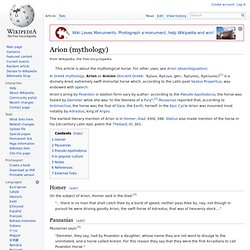
On the subject of Arion, Homer said in the Iliad:[3] "... there is no man that shall catch thee by a burst of speed, neither pass thee by, nay, not though in pursuit he were driving goodly Arion, the swift horse of Adrastus, that was of heavenly stock ...” Pausanias says:[4] "Demeter, they say, had by Poseidon a daughter, whose name they are not wont to divulge to the uninitiated, and a horse called Areion. For this reason they say that they were the first Arcadians to call Poseidon Horse. " Buraq. Al-Burāq (Arabic: البُراق al-Burāq "lightning") is a steed, described as a creature from the heavens which transported the prophets.

The most commonly told story is how in the 7th century, Al-Buraq carried the Islamic prophet Muhammad from Mecca to Jerusalem and back during the Isra and Mi'raj or "Night Journey", which is the title of one of the chapters (sura), Al-Isra, of the Quran. Description[edit] While the Buraq is almost always portrayed with a human face in far-eastern and Persian art, no Hadiths or early Islamic references allude to it having a humanoid face. This, which found its way into Indian and Persian Islamic art, may have been influenced by a misrepresentation or translation from Arabic to Persian of texts and stories describing the winged steed as a "... beautiful faced creature.
" An excerpt from a translation of Sahih al-Bukhari describes Al-Buraq: Then a white animal which was smaller than a mule and bigger than a donkey was brought to me. ... Centaur. Brooklyn Museum - Centauress - John La Farge - overall A centaur (/ˈsɛntɔːr/; Greek: Κένταυρος, Kéntauros, Latin: centaurus) or hippocentaur[1][2][3] is a mythological creature with the head, arms, and torso of a human and the body and legs of a horse.[4] In early Attic and Beotian vase-paintings (see below), they are depicted with the hindquarters of a horse attached to them; in later renderings centaurs are given the torso of a human joined at the waist to the horse's withers, where the horse's neck would be.
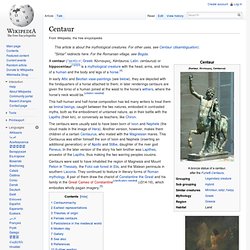
[citation needed] This half-human and half-horse composition has led many writers to treat them as liminal beings, caught between the two natures, embodied in contrasted myths, both as the embodiment of untamed nature, as in their battle with the Lapiths (their kin), or conversely as teachers, like Chiron. Centaurs were said to have inhabited the region of Magnesia and Mount Pelion in Thessaly, the Foloi oak forest in Elis, and the Malean peninsula in southern Laconia. The John C. Chiron. In Greek mythology, Chiron /ˈkaɪrən/ (also Cheiron or Kheiron; Greek: Χείρων "hand"[1]) was held to be the superlative centaur among his brethren.
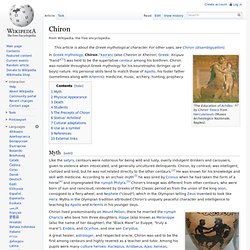
Chiron was notable throughout Greek mythology for his kourotrophic (bringer up of boys) nature. His personal skills tend to match those of Apollo, his foster father (sometimes along with Artemis); medicine, music, archery, hunting, prophecy. Myth[edit] Amphora suggested to be Achilles riding Chiron. British Museum ref 1956,1220.1 . There is also a persistent link with Peleus throughout Chiron's myth. Physical Appearance[edit] Haizum. Hippocampus (mythology) The hippocampus or hippocamp, also hippokampoi (plural: hippocampi or hippocamps; Greek: ἱππόκαμπος, from ἵππος, "horse" and κάμπος, "monster"[1]), often called a sea-horse[2] in English, is a mythological creature shared by Phoenician[3] and Greek mythology, though the name by which it is recognised is purely Greek.
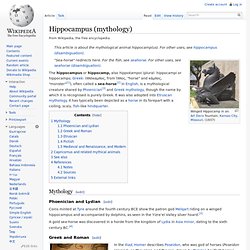
It was also adopted into Etruscan mythology. It has typically been depicted as a horse in its forepart with a coiling, scaly, fish-like hindquarter. Coins minted at Tyre around the fourth century BCE show the patron god Melqart riding on a winged hippocampus and accompanied by dolphins, as seen in the Yizre'el Valley silver hoard.[3] Hippogriff. The hippogriff is a legendary creature which resembles a winged horse with the head and upper body of an eagle.
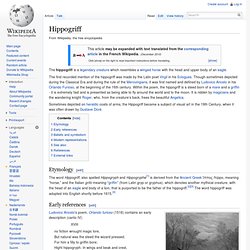
Sometimes depicted on heraldic coats of arms, the Hippogriff became a subject of visual art in the 19th Century, when it was often drawn by Gustave Doré. Etymology[edit] Ichthyocentaurs. In late poetical Greek mythology ichthyocentaurs (or ikhthyokentauroi) were a pair of centaurine sea-gods with the upper body of a man, the lower front of a horse, and the tail of a fish.
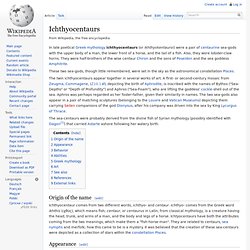
Also, they wore lobster-claw horns. They were half-brothers of the wise centaur Chiron and the sons of Poseidon and the sea goddess Amphitrite. The sea-centaurs were probably derived from the divine fish of Syrian mythology (possibly identified with Dagon[1]) that carried Astarte ashore following her watery birth. Ipotane. Karkadann. The Karkadann (from Kargadan, Persian: كرگدن "Lord of the Desert"[citation needed]) was a mythical creature said to live on the grassy plains of India and Persia.
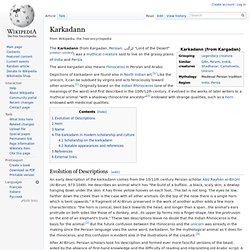
The word kargadan also means rhinoceros in Persian and Arabic. Kelpie. The kelpie is a supernatural water horse from Celtic folklore that is believed to haunt the rivers and lochs of Scotland and Ireland; the name may be from Scottish Gaelic cailpeach or colpach "heifer, colt".[1] Folklore[edit] In mythology, the kelpie is described as a strong and powerful horse.

It is a white and sky blue colour and appeared as a lost pony, but could be identified by its constantly dripping mane. Its mane and tail are a bit curly. Its skin was said to be like that of a seal, smooth but as cold as death when touched. Longma. Longma (simplified Chinese: 龙马; traditional Chinese: 龍馬; pinyin: lóngmǎ; Wade–Giles: lung-ma; lit.
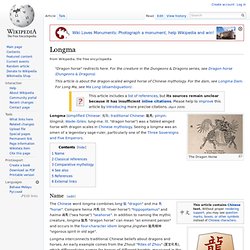
"dragon horse") was a fabled winged horse with dragon scales in Chinese mythology. Seeing a longma was an omen of a legendary sage-ruler, particularly one of the Three Sovereigns and Five Emperors. Name[edit] The Chinese word longma combines long 龍 "dragon" and ma 馬 "horse". Compare hema 河馬 (lit. Nuckelavee. Onocentaur. Onocentaur (Latin: onocentaurus, from Ancient Greek: Ονοκένταυροι - Onokéntauroi) is an animal from Medieval bestiaries, similar to the centaur, but part human, part donkey. As with many liminal beings, the onocentaur's nature is one of conflict between its human and animal components.[1] The first mention by Pythagoras was in the time of rule of Ptolemy II Philadelphus, as quoted by Claudius Aelianus in De Natura Animalium.
Aelian as well uses term onokentaura for description of the female form.[2] He interpreted the onocentaur as: "its body resembles that of an ass, its colour is ashen but inclines to white beneath the flanks. It has a human chest with teats and a human face surrounded by thick hair. It may use its arms to seize and hold things but also to run. See also[edit] Pegasus. Púca. The púca (Irish for spirit/ghost), pooka, phouka, phooka, phooca or púka is primarily a creature of Irish folklore.[1] Considered to be bringers both of good and bad fortune, they could either help or hinder rural and marine communities. The creatures were said to be shape changers which could take the appearance of black horses, goats and rabbits.
Etymology[edit] Malevolent or benevolent nature[edit] Sleipnir. Simurgh. Tikbalang. Uchchaihshravas. George Harrison's Dark Horse Records music label uses a logo inspired by Uchchaihshravas. Legends and textual references[edit] Mahabharata mentions that Uchchaihshravas rose from the Samudra manthan ("churning of the milk ocean") and Indra - the god-king of heaven seized it and made it his vehicle (vahana). Unicorn. White horse (mythology) From earliest times white horses have been mythologized as possessing exceptional properties, transcending the normal world by having wings (e.g. Pegasus from Greek mythology), or having horns (the unicorn). As part of its legendary dimension, the white horse in myth may be depicted with seven heads (Uchaishravas) or eight feet (Sleipnir), sometimes in groups or singly. There are also white horses which are divinatory, who prophesy or warn of danger.